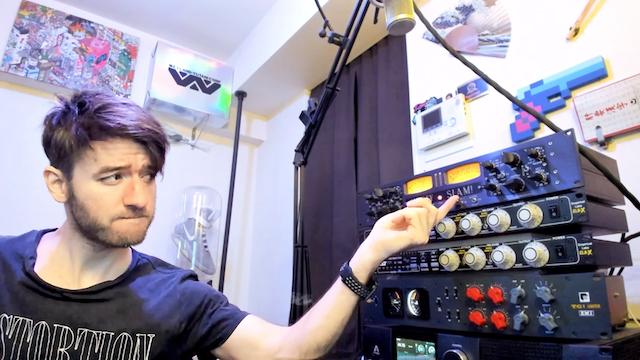Johnny Massacre’s Manley Eureka Moment
 Tokyo, Japan – November 2018… Meet British-born rapper, DJ, and producer Johnny Massacre, the genius behind the smash YouTube hit “Ultrasound,” which has 8.3 million views and counting. Massacre works out of a hybrid personal studio in Tokyo, where he says his career goal is to “resurrect the spirit of Biggie Smalls.” And to take his music where he wants it to go, he uses a hybrid studio setup where plug-ins cohabitate with his Manley SLAM and Variable Mu hardware.
Tokyo, Japan – November 2018… Meet British-born rapper, DJ, and producer Johnny Massacre, the genius behind the smash YouTube hit “Ultrasound,” which has 8.3 million views and counting. Massacre works out of a hybrid personal studio in Tokyo, where he says his career goal is to “resurrect the spirit of Biggie Smalls.” And to take his music where he wants it to go, he uses a hybrid studio setup where plug-ins cohabitate with his Manley SLAM and Variable Mu hardware.
“I don’t like working in the box completely,” he says. “I do a lot of processing of drums and synths with analog gear, and then once I’ve got something good I’ll resample it. Then I can get to work on the production side in the box, but it has to go through analog first.”
Massacre says he’s not too concerned about how versatile gear his gear is; “it just has to take my stuff to the next level, that’s all I care about, and what Manley gear does to the sound-there’s no way in hell you can do that with software,” he says. “So, that’s also quite inspirational.”
Massacre, a proud owner of both a SLAM and a Variable Mu, says that before he settled on Manley equipment as permanent components of his chain, he experimented with a variety of other hardware units as well as plug-ins. He’s been renting a Massive Passive, and plans to purchase one in the new year. “I had a Eureka moment,” he says. “I was using various hardware compressors and I couldn’t get the loudness that I wanted on the master, compared to commercial releases.” He stuck a Variable Mu at the front of the chain, and he instantly found that certain loudness he was seeking. “It squashes the audio and makes it malleable so you can get the gain you want.
“Now, whenever I’ve finished my track I’ll stick it though the Variable Mu, and the Massive Passive, and then the SLAM, and then I’m confident I can get the loudness that I want,” says Massacre. “The SLAM makes things louder in the most ridiculously transparent way. When I look at the waveform after I track something, all of the quiet parts have been raised and all of the loud parts pretty much look the same on the waveform. Unless you go mad with it, it doesn’t audibly distort the sound; it simply makes it louder and fatter with no artifacts.”
Massacre also puts his own vocals through SLAM when he broadcasts his YouTube show, where he does everything from play favorite tracks to review recent films. “I think it’s important your voice sounds good on YouTube, as most YouTubers don’t really comprehend truly how much that adds to the experience,” he says. “I use the Manley SLAM for that. The preamps are so clean. You can get a really nice gain and make your voice sound professional. I go quite hard on the ELOP and use the FET for maximum effect.”
Massacre is also a drum & bass producer; he enjoys listening to old bass-heavy, low-fi tracks through his Manley SLAM. “Drum & bass was a very DIY scene,” he explains. “The old drum and bass, the kicks and the snares are so dynamic, they’re almost too dynamic. They stick out so much, and then you put the SLAM on it and it’s all so perfectly framed. The SLAM is so powerful that it can transform low-res audio recorded on a potato into something usable.
“In drum & bass people sometimes go overboard with the bass; they want to push it as much as they can to simulate the dance floor experience, but they push it way too far,” he adds. “So by the time it gets to the master, it’s hard to work with it, but when you stick that kind of bass into a SLAM it just makes it so perfectly shaped and it’s never too much, it just kind of smooths it off at the right point. I thought, all these people who made these songs, if they had used the SLAM back in the day it would have just been even better.”
Massacre is hoping to expand his production services in the coming months. His plan to add a Manley Massive Passive to his arsenal is part of a long-term scheme to open his studio to the public, and to do more of his own mastering-an idea that’s been percolating since his days as a university student.
“As part of my course, they took us to a studio where we could see a mastering engineer doing his job, and he had a Massive Passive,” he says. “As soon as I saw that thing, I knew no one could design something like that and not be ridiculously passionate about what they were doing. I felt that design betrayed the creators’ whole work ethic and ethos, and then when I listened to it-I’ve wanted it all my life. Massive Passive is surgical: You can go deep into the sound and do whatever you want. If you boost high mids on a software plug-in, you will bleed your ears, but with the Massive Passive it sounds like a record. It’s just a magical piece of gear.”


